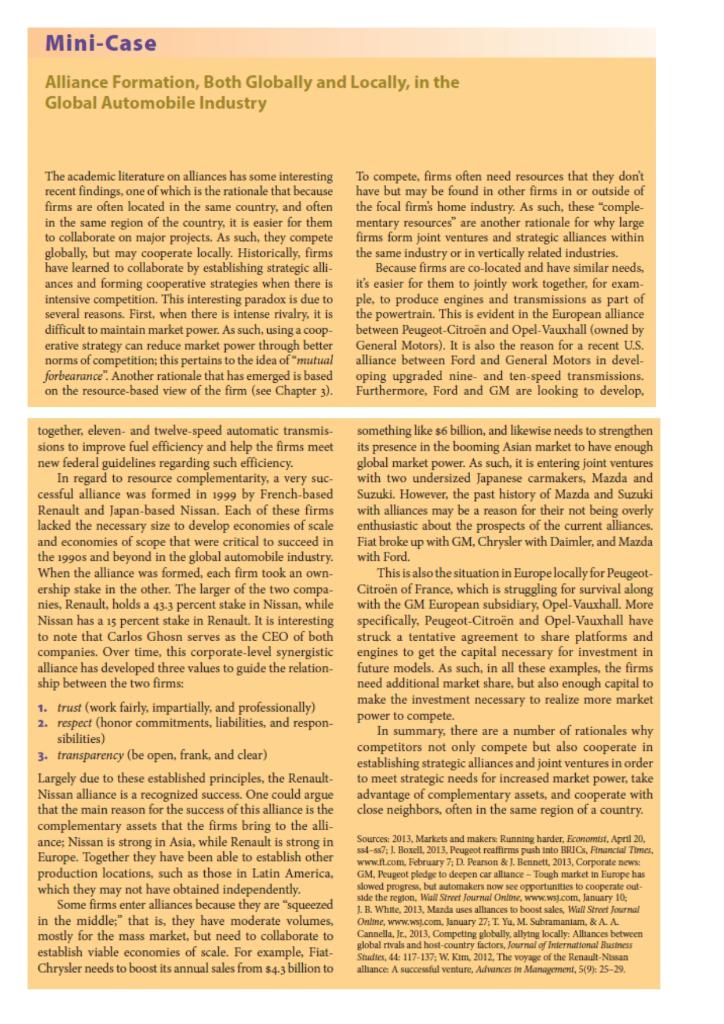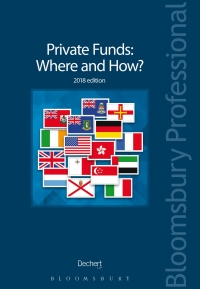

Alliance Formation, Both Globally and Locally, in the Global Automobile Industry The academic literature on alliances has some interesting To compete, firms often need resources that they don't recent findings, one of which is the rationale that because have but may be found in other firms in or outside of firms are often located in the same country, and often the focal firm's home industry. As such, these "complein the same region of the country, it is easier for them mentary resources" are another rationale for why large to collaborate on major projects. As such, they compete firms form joint ventures and strategic alliances within globally, but may cooperate locally. Historically, firms the same industry or in vertically related industries. have learned to collaborate by establishing strategic alli- Because firms are co-located and have similar needs, ances and forming cooperative strategies when there is it's easier for them to jointly work together, for examintensive competition. This interesting paradox is due to ple, to produce engines and transmissions as part of several reasons. First, when there is intense rivalry, it is the powertrain. This is evident in the European alliance difficult to maintain market power. As such, using a coop- between Peugeot-Citron and Opel-Vauxhall (owned by erative strategy can reduce market power through better General Motors). It is also the reason for a recent U.S. norms of competition; this pertains to the idea of "mutual alliance between Ford and General Motors in develforbearance". Another rationale that has emerged is based oping upgraded nine- and ten-speed transmissions. on the resource-based view of the firm (see Chapter 3). Furthermore, Ford and GM are looking to develop. together, eleven-and twelve-speed automatic transmis- something like $6 billion, and likewise needs to strengthen sions to improve fuel efficiency and help the firms meet its presence in the booming Asian market to have enough new federal guidelines regarding such efficiency. global market power. As such, it is entering joint ventures In regard to resource complementarity, a very suc- with two undersized Japanese carmakers, Mazda and cessful alliance was formed in 1999 by French-based Suzuki. However, the past history of Mazda and Suzuki Renault and Japan-based Nissan. Each of these firms with alliances may be a reason for their not being overly lacked the necessary size to develop economies of scale enthusiastic about the prospects of the current alliances. and economies of scope that were critical to succeed in Fiat broke up with GM, Chrysler with Daimler, and Mazda the 1990 and beyond in the global automobile industry. with Ford. When the alliance was formed, each firm took an own- This is also the situation in Europe locally for Peugeotership stake in the other. The larger of the two compa- Citron of France, which is struggling for survival along nies, Renault, holds a 43-3 percent stake in Nissan, while with the GM European subsidiary, Opel-Vauxhall. More Nissan has a 15 percent stake in Renault. It is interesting specifically, Peugeot-Citron and Opel-Vauxhall have to note that Carlos Ghosn serves as the CEO of both struck a tentative agreement to share platforms and companies. Over time, this corporate-level synergistic engines to get the capital necessary for investment in alliance has developed three values to guide the relation- future models. As such, in all these examples, the firms ship between the two firms: need additional market share, but also enough capital to 1. trust (work fairly, impartially, and professionally) make the investment necessary to realize more market 2. respect (honor commitments, liabilities, and respon- power to compete. sibilities) In summary, there are a number of rationales why 3. transparency (be open, frank, and clear) competitors not only compete but also cooperate in Largely due to these established principles, the Restablishing strategic alliances and joint ventures in order due to these established principles, the Renault- to meet strategic needs for increased market power, take Nissan alliance is a recognized success. One could argue advantage of complementary assets, and cooperate with that the main reason for the success of this alliance is the close neighbors, often in the same region of a country. complementary assets that the firms bring to the alliance; Nissan is strong in Asia, while Renault is strong in Sources: 2013, Murkets and makers: Runntng harder, Ecanomist, Apeil 20, production locations, such as those in Latin America, GM. Peupeot pledpe to deepen car allance - Tough market in Eiurope has which they may not have obtained independently. Sllowed progres, but autamaken now see opportunities to coopente out. Some firms enter alliances because they are "squeezed side the regon, Wall Siret Joursal Onime, wwx.wstcom, lanuary 10; in the middle;" that is, they have moderate volumes, Ontume, www.msicom, lanuary 27; I Yu, M. Suhramantam, \& A. A. mostly for the mass market, but need to collaborate to Cannella, It, 2013, Compettng ghobally, allytny locally: Alliances between establish viable economies of scale. For example, Fiatglobal rivals and hoit-country factors, Journal of iniemational hiemess Stadee, 44: 117-137; W. Kim, 2012, The voy a of the Renall-Nhan Chrysler needs to boost its annual sales from 34.3 billion to allance A succesaful venture, Advunce in Manaxomert, 5(9) : 25-29. Case Discussion Questions 1. Why firms develop and use cooperative strategies such as strategic alliances and joint ventures? Search and give specific examples to three strategic alliances/ joint ventures from different industries (NOT automobile industry). Provide the source (e.g. news article link) for each example. 2. What is the relationship between the core competencies a firm possesses, the core competencies the firm feels it needs, and decisions to form cooperative strategies? 3. What does it mean to say that the partners of an alliance have "complementary assets"? What complementary assets do Renault and Nissan share? 4. What are the risks associated with the corporate-level strategic alliance between Renault and Nissan? What have these firms done to mitigate these risks? 5. Is it possible that some of the firms mentioned in this Mini- Case (e.g., Renault, Nissan, Mazda, Peugot-Citroen, Opel- Vauxhall) might form a network cooperative strategy? If so, what conditions might influence a decision by these firms to form this particular type of strategy








